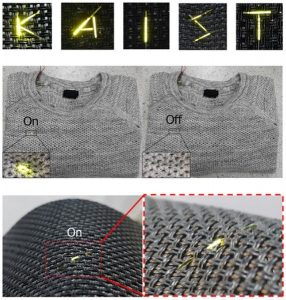Integration of electronics into textiles (e-textiles) has emerged as a promising new technology because it can offer tremendous possibilities in many fields of science and fashion, leading to new applications and products.

Organic light-mitting fibers woven into knitted clothes. Source: The Korea Advanced Institute of Science and Technology (KAIST)
Numerous studies have been dedicated to developing the organic light-emitting fibers for wearable electronics. However, conventional fibre-based light emitting devices have limitations of their much lower emission performance compared to those fabricated on flat substances. So, a research team led by Professor Kyung Cheol Choi in the School of Electrical Engineering at Korea Advanced Institute of Science and Technology (KAIST) in South Korea has developed a simple and cost effective solution which is a fabrication technique, using a low-temperature process. Using their technique, the team successfully fabricated the thin and flexible fibre-based organic light-emitting diodes (fiber OLEDs) without any reduction in performance.
A video below briefly introduces OLED fibers. See source here.
https://www.youtube.com/watch?v=J9keKez6ryY
In the manufacturing process, eliminating the high temperature and vacuum processes is crucial since fibers such as cotton, polyester, nylon are thermally delicate. So, the research team used a thermal annealing and dip coating method in cylindrical fibers at as low temperature as possible.
The team also designed the structure of fiber OLEDs to improve the electron injection efficiency on the fibers and to employ a low-temperature thermal annealing processable cathode, which significantly impacts on its performance. According to the researchers, their revised structure clearly exhibited high luminance and current efficiency compared to those of previously reported fiber-based OLEDs. In addition, the dip coating method at low temperature improved surface roughness and sufficiently ensured the device stability without any planarization layer.
Moreover, the technology demonstrates the scalability of the proposed fabrication scheme with diameter ranging from 300μm to 90μm, thinner than human hair. The research team ensured that the fiber OLEDs could be weavable into textiles and knitted clothes without any reduction in emission performance because their inherent empty spaces and the wavy structures enhance flexibility and stress distribution of the OLEDs.

Fiber OLEDs with different diameters. Source: The Korea Advanced Institute of Science and Technology (KAIST)
Professor Choi emphasized the versatility for application on delicate fibers by stating that the technology to incorporate display screens into our clothing is now a reality, and organic light-emitting clothes will have a significant influence not only on the e-textile industry, but also on the automobile and healthcare industries.
A video below briefly shows how wearable e-textiles may be used in future. See source here.
Reference:
- Seonil Kwon, Hyuncheol Kim, Seungyeop Choi, Eun Gyo Jeong, Dohong Kim, Somin Lee, Ho Seung Lee, Young Cheol Seo, Kyung Cheol Choi. Weavable and Highly Efficient Organic Light-Emitting Fibers for Wearable Electronics: A Scalable, Low-Temperature Process. Nano Letters, 2017; 18 (1): 347 DOI: 10.1021/acs.nanolett.7b04204
- The Korea Advanced Institute of Science and Technology (KAIST). (2018, January 10). Fiber OLEDs, thinner than a hair. ScienceDaily. Retrieved January 15, 2018 from www.sciencedaily.com/releases/2018/01/180110101019.htm
- The Korea Advanced Institute of Science and Technology (KAIST). (2017, September 4). Light-emitting fibers for wearable displays. AsianScientistNewsroom. Retrieved January 15, 2018 from https://www.asianscientist.com/2017/09/tech/oled-flexible-wearable-display/
-Subi Kim
